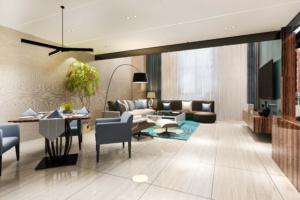Smart and Stylish Homes: Integrating Technology into Interior Design
by vsts-seo |June 12, 2024 |1 Comments | Blogs | Home interior designsSmart and Stylish Homes: Integrating Technology into Interior Design
In today’s fast-paced world, the concept of a home has evolved from a simple living space to a sophisticated hub of comfort, convenience, and style. The integration of technology into interior design is revolutionizing the way we live, creating smart homes that are not only highly functional but also aesthetically pleasing. Top interior designers, including the best interior designers in India, are leading the way in incorporating cutting-edge technology into both home and commercial interiors. Here’s how smart technology is transforming modern interiors.
1. Seamless Integration with Design
One of the key trends in smart home technology is its seamless integration into the overall design. Gone are the days when tech gadgets were bulky and intrusive. Modern smart devices are sleek, minimalistic, and often designed to blend in with home decor. For instance, smart speakers and assistants like Amazon Echo or Google Home come in various shapes, colors, and materials that complement any interior style, from contemporary to rustic.
2. Lighting Control
Smart lighting systems have become a staple in stylish homes. These systems allow you to control the brightness, color, and even the ambiance of your lighting through a smartphone app or voice commands. Imagine setting the perfect mood for a dinner party with warm, dimmed lights or waking up to a simulated sunrise. Brands like Philips Hue and LIFX offer a wide range of smart bulbs and fixtures that can be integrated into any design scheme.
3. Intelligent Climate Control
Maintaining the perfect temperature in your home is now easier and more energy-efficient with smart thermostats like Nest or Ecobee. These devices learn your preferences over time and adjust the heating and cooling accordingly, ensuring comfort while saving on energy bills. They can be controlled remotely, so you can always come home to the perfect climate.
4. Smart Furniture
Furniture has also seen a technological upgrade. From coffee tables with built-in charging stations to sofas with integrated speakers, smart furniture combines functionality with modern design. These pieces not only serve their primary purpose but also enhance the convenience and connectivity of your living space.
5. Enhanced Security
Smart home security systems provide peace of mind while blending seamlessly with your home’s design. Sleek cameras, smart doorbells, and integrated alarm systems offer robust security without compromising on style. Products from brands like Ring and Arlo are designed to be unobtrusive yet highly effective.
6. Entertainment Systems
Modern entertainment systems are more than just TVs and speakers. They are integrated multimedia hubs that offer a cinematic experience at home. Wall-mounted OLED TVs with almost invisible bezels, hidden speakers, and smart remotes contribute to a clean, uncluttered look while providing top-notch entertainment.
7. Customization and Personalization
One of the greatest advantages of smart home technology is the ability to customize and personalize your living space. With smart home hubs and automation systems like Samsung SmartThings or Apple HomeKit, you can create routines and scenes that fit your lifestyle. Whether it’s a “”Good Morning”” routine that gradually wakes you up with lights and music or a “”Movie Night”” scene that dims the lights and lowers the shades, the possibilities are endless.
At Vj professional The integration of technology into interior design is not just about adding gadgets to your home; it’s about creating a harmonious environment where technology enhances your lifestyle without detracting from the aesthetics. Smart homes are the future, offering convenience, efficiency, and style all in one.
